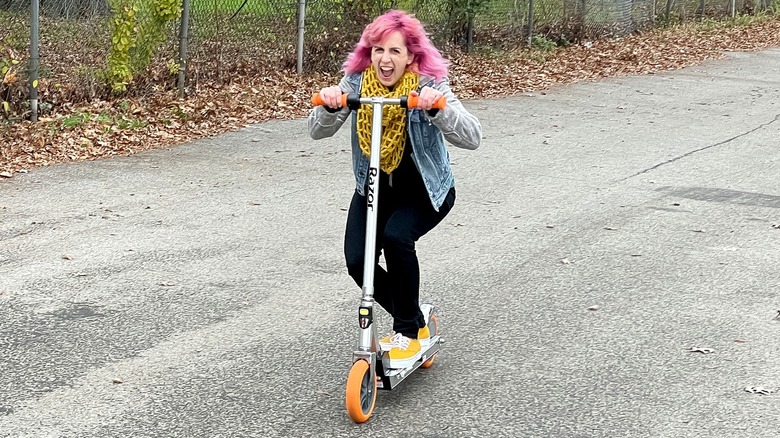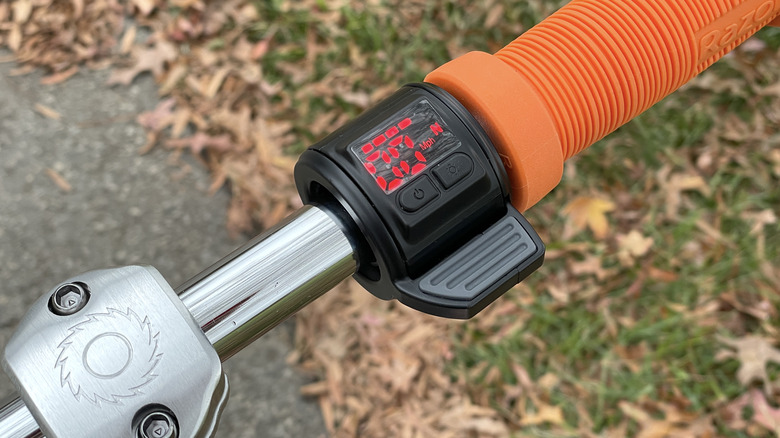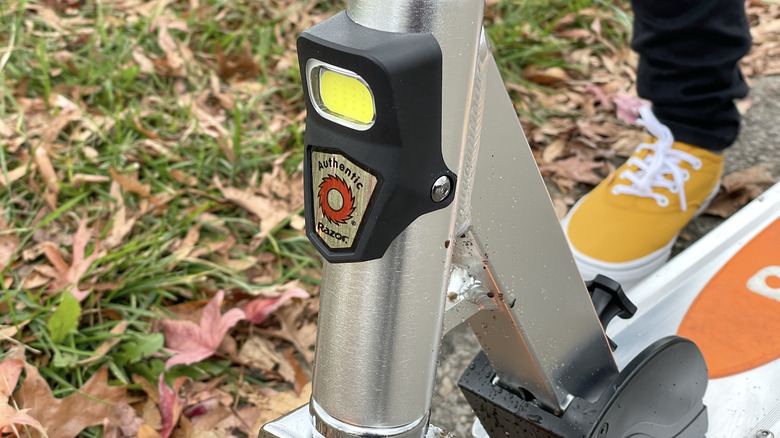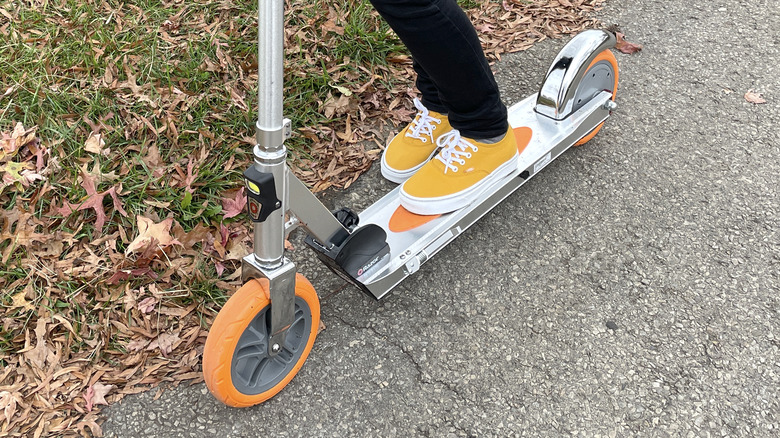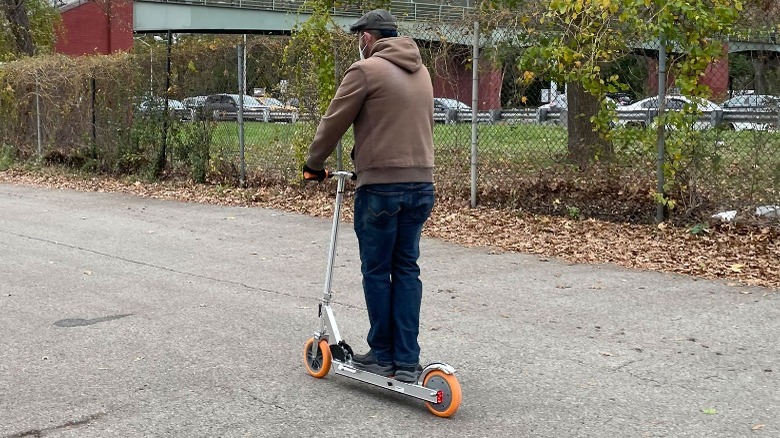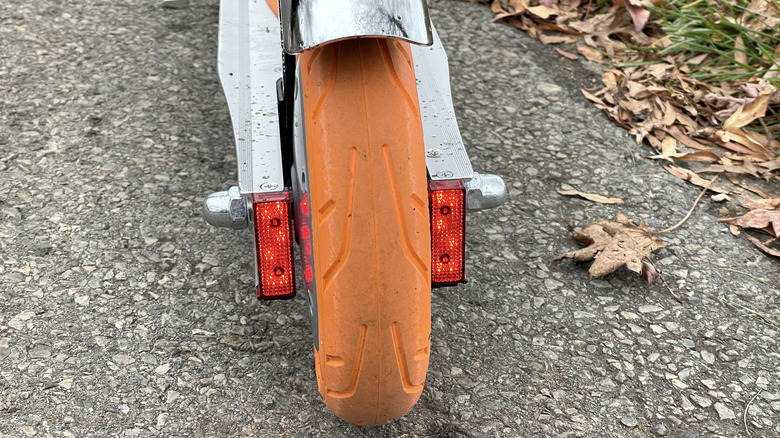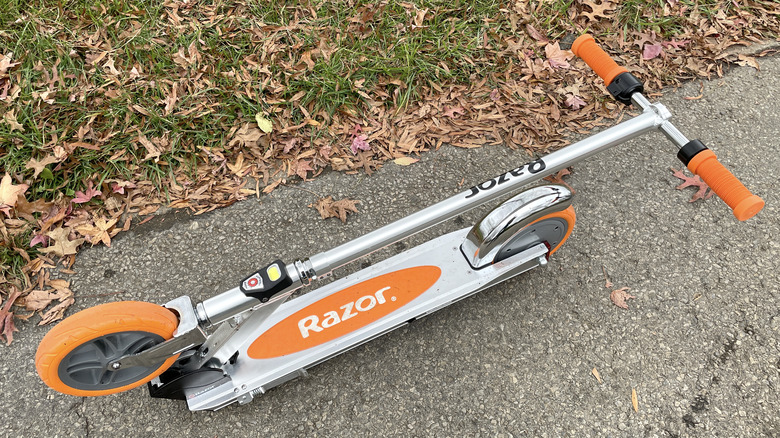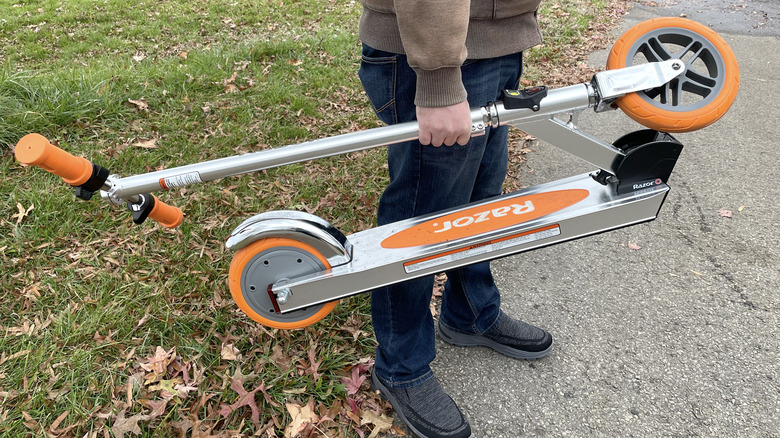Razor Icon Electric Scooter Review: Big, Heavy, And Fun
- Simple to unpack and set up (but a little tricky to do it solo)
- Easy to ride, even for a complete novice
- Fun to use and hits some pretty decent speeds
- Head and tail lights for increased visibility at night
- Too big and heavy to comfortably tote around
- Handbrake feels a tad too sensitive
- Throttle feels not quite sensitive enough
- Battery life and charging times could be better
As I'm typing this I keep looking over at the scooter sitting by my desk, and I feel conflicted. My wife and I have been having a really good time with the Razor Icon (via Razor) I was sent for review — despite neither of us being unfamiliar with electric scooters in any capacity — but we live in a relatively small New York apartment where space, both inside and out, is limited.
Don't get me wrong, there's a lot to appreciate here, even as someone who hasn't been on a scooter of any kind in decades (and has never ridden an electric scooter before). It's just that some of the particulars of its design and construction don't entirely gel with me. Of course, your mileage may (literally) vary, based on where you live and what you may need a tiny two-wheeled Cadillac for.
Clearly, my reservations on the not-as-small-space-friendly-as-I-expected nature of Razor's new $600 personal conveyance device aren't severe enough to make me dislike what I've experienced, as evidenced by the review score, but I think it's important to make this clear: There are a few caveats to keep in mind before purchasing one for yourself. Especially if you have a small living space.
Let's set it up
Unpacking the Razor Icon for the first time wasn't quite what I expected. To be fair I'm not sure what I was expecting in the first place but it wasn't a big, bright warning card telling me I'd need to charge the scooter for at least eight hours before using it for the first time. So I guess don't expect to hop on your new scooter as soon as you open the box.
Past the warning was a small assembly project, as the Icon comes in a few pieces: The scooter, the handlebars, and the bar connecting them both. Once I had everything out of the box (the scooter pieces, charger, instructions, and included Allen wrench) I was ready to get started. Putting the Icon together was pretty simple since it's just a matter of bolting the handlebars in place, connecting a couple of wires, then bolting the rest of it together, but it did pose more of a challenge than you might think. At least when you're doing it by yourself.
What makes it a bit tricky is the lack of any sort of guide rails or slots to make sure the bar is properly aligned with the wheel — you just have to eyeball it. Maybe it's a manufacturing thing but I dunno, I feel like having something (even just a little metal ridge) to help you make sure everything is straight would have been preferable to loosening, readjusting, checking, loosening, and so on several times.
How's it built?
Minor assembly nitpicking aside, the Icon looks and feels like a tank. Or at least the electric scooter equivalent of one. The metal is dense and sturdy, the handlebars have a nice firm squishiness to them (yes that's contradictory but that's the best way I can describe it), and there's a nice little rubbery cover to protect the charging port when not in use. That last one is probably common for most electric scooters but I still think it's a clever (and necessary) idea.
The mechanism that's used to collapse the handlebars down to make the Icon ever so slightly more compact is also really sturdy, with lots of thick metal bits to lock everything in place. Though a word of warning: Make sure you tighten the locking screw (it looks like a small black knob just behind the front wheel) as much as you can.
We didn't have a mishap when riding it around, thankfully, but at one point I did notice that it had loosened itself. It still would have had to be pulled out in order to engage the mechanism and cause the scooter to collapse, but one good bump could have caused a problem. I'm chalking this particular issue up to user error though, as I initially worried about over-tightening the screw and didn't expect it to loosen like that with use. During a follow-up ride where I tightened it as much as I could beforehand there were no signs of anything coming undone.
Somewhat limiting power
Now, the Icon doesn't have bad battery life. According to Razor you can get roughly 18 miles out of a single charge. Or possibly an hour depending on which comes first? The directions weren't super clear on that point. But my point is, it runs well and for what seems to be a decent amount of time — it certainly didn't run out of juice while I was using it. And really, even if it did run out of power it would still work as a regular push scooter.
It does require a fair bit of charging, though. At least going by what Razor recommends. Aside from the initial eight-plus hours you need to charge the scooter out of the box, the directions also strongly suggest charging the Icon after every single use. Which is fine? I guess?
It's not a massive inconvenience or anything, and it's probably intended to make sure you don't accidentally head out with a partial or low charge, but when space is limited it can be a little annoying to have to set it up near an outlet for several hours after you take it for a spin. Maybe I'm being unfair with this one, I dunno, but it's what Razor says I should do and I'm not familiar enough with electric scooters to question it.
Hitting the road
Bear in mind I have less experience with riding electric scooters than I have with glass blowing (seriously) when I say that using the Icon was incredibly simple and intuitive. Again, I'm not sure if that's just the norm for electric scooters but aside from some initial awkwardness with kicking off to get things started, it took almost no time at all to get a feel for it. And I definitely appreciated having three speed settings (Easy, Normal, Sport), which helped me ease myself into the process further.
Kicking off the ground and steadily pushing down on the throttle (located at the right thumb) started to feel pretty smooth after a half hour or so of playing around. And once I got used to Easy mode's 6 mph limit I ended up having even more fun with Normal's 12 mph cap. I'll admit I didn't push it up to the 18 mph maximum of Sport mode because I didn't have a helmet on-hand (wear a helmet when riding scooters like this!) and didn't want to risk injury, but the overall ride at the speeds I did try was pretty smooth.
The "flat-free" tires had a good grip, and I didn't have to concentrate on keeping my balance anywhere near as much as I was expecting to. Turning was a little awkward, and the turning radius was a bit large, but I think that's a combination of my not being super comfortable on a scooter and the front wheel not being able to turn fully — which I'm certain is to keep it from going 90-degrees and making the rider face-plant in the street.
Let's talk safety
Along with not being able to turn so sharply that physics will try to end you, the Icon also has a few other safety (and safety-adjacent) features. Such as the built-in digital speedometer that displays in mph by default but can be changed to km/h. You can also use the buttons beneath the digital display to adjust modes and turn the headlight (yes, there's a headlight) on or off.
The throttle feels like it has a bit of a "dead zone" to it, where it won't kick on until you push it past a certain point, which makes tentatively getting up to speed when you've never done this before a little awkward but I'm pretty sure that's to keep you from accidentally going too fast when kicking off. Conversely, the handbrake (located under the left thumb) feels a tiny bit too sensitive. Even a slight press caused the scooter to brake much harder than I expected it to, and you do not want to jam the brake down.
Fortunately, it's something I was able to get a better feel for as I kept using the Icon. And if you don't like or don't want to use the handbrake there's always the rear brake that sits just over the back wheel. And either brake option will cause the brake lights (yes, there are also brake lights) to light up as well.
The size problem
As much as I did enjoy riding the Icon, I'm far less fond of its lack of portability. Granted, some of that's on me because I didn't properly read into the part of the description that says it's "easy to hand carry on public transportation and easily folds for storage at home," but this thing is something of a beast.
Its overall size and weight probably won't be an issue if you have the room for it, or jump on and ride from point A to point B with no need to carry it along your route. However, that's not ideal for where we live. Our apartment is fairly tiny, so storing it (even when folded up) is a challenge. As of writing we still haven't quite figured out where to put it when not in use. And storage doesn't matter when I have to charge it, which requires finding the most out-of-the-way spot next to a piece of furniture I can before plugging it in.
The Icon is also heavy. Not impossible to carry, certainly, but those 26.5 lbs can be a strain if you have to tote it along for a bit (through a busy sidewalk, up or down stairs, etc) before you can open it up and start scooting. And the front wheel doesn't lock into place when it's collapsed, so trying to push it along on one wheel while it's folded up doesn't work very well, either.
Razor Icon verdict
To be clear, despite my own unfamiliarity with electric scooters and being somewhat taken by surprise by the Razor Icon's size and weight, I have been enjoying it quite a lot. And I can acknowledge that my particular circumstances make said size and weight a bit more of a problem for me than it would likely be for others. Still, though, it's kind of a pain for me to store or carry around. It's not something I'd consider ideal for people who don't have a decent amount of room to give it.
Coasting along at up to 12 mph was a lot of fun, and once I started to get a better feel for turning (mostly due to, again, inexperience) it was pretty easy to steer through some rather narrow spots with precision. All of the built-in digital elements — the speedometer, handbrake, headlight, and brake lights — made the Icon feel rather premium, in addition to being an extra layer of safety.
I don't necessarily think I'd recommend the Razor Icon for a complete novice like myself because $600 is a big ask for something you've never even attempted before, but I do appreciate how easy it is to use. Even if you have absolutely no idea what you're doing.
Also, take a peek at the Razor E Prime III electric scooter and the Turboant X7 Pro foldable electric scooter. Both present some interesting alternative features — and significantly different prices.
